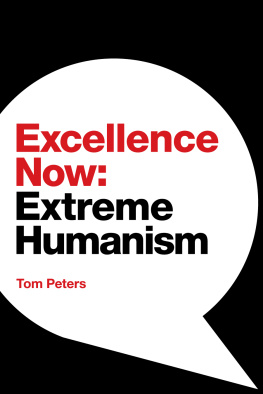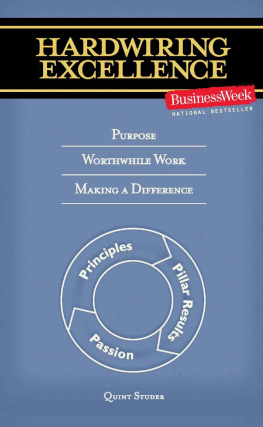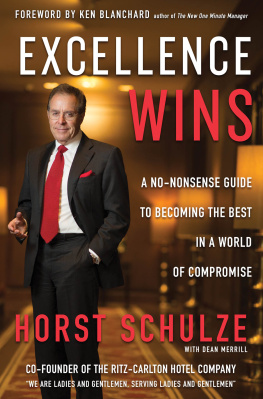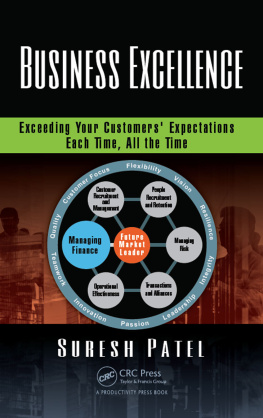I will always work to make you proud.
Contents
Nobody Knows the Drivers Name: Create a Culture of No Ego
The Marketplace Is Bigger Than Your Bus: Listening Means More Than Just to Customers
The Bus Is Leaving, So Get Everybody On Board!: Sell Your Organization on the New Strategic Direction
Chart Your Route, Then Fill the Tank: Spend Money Purposely to Support Your Strategy
To Avoid Getting a Ticket, Watch Your Own Speedometer: Embrace Accountability in All That You Do
Estimated Gas Mileage Doesnt Cut It: Count What Counts!
Professional Drivers Obsessively Check Their Gauges: Foster a Culture of Analysis and Action
Where the Rubber Meets the Road: Youre the Professional Driver, So Act Like It!
The Road to Revolutionary Results
The bus company I run in Rochester, New York, was once as beleaguered as any organization in America. When I was appointed CEO of the Rochester Genesee Regional Transportation Authority (RGRTA) in 2004, I received a nice opening day surprisea massive $27.7 million budget deficit. Previous management had seen the crisis coming but hadnt taken steps necessary to avert it. Now, with a total budget of around $70 million, we were cooked. During my first weeks in the corner office, colleagues were advising me that we would survive only if we took not one but all of the following drastic steps: raising fares 40 percent across the board, reducing service by 65 percent, doubling fares on the disabled population we served, and axing about a quarter of our workforce.
We didnt do any of these things. Rather, we focused on transforming our business from the bottom up so that we could execute better. In two years time, we turned that $27.7 million deficit into a $19.7 million surplus, a $47.2 million swing. Since then, its only gotten better. For four years in a row, weve actually made moneymore than $29.7 million and countingwhile also growing our organization (our annual budget is now around $85 million). Since 2004, the number of people we carry has increased by more than 20 percent, a rate nearly 50 percent higher than the national average. Our routes today pick up more people for each mile we drive than they used toover 50 percent more. Our buses are cleaner, and customer satisfaction, which had never before even been measured, is on the rise.
Oh, and try this on for size: In 2008, at a time of recession, when airlines were charging customers to bring luggage on board, FedEx was raising its delivery prices, and many public transit systems were pushing through not one but two fare increases, we actually lowered our fareto just $1, a price not seen since 1991.
Government has underperformed for so long that people doubt any agency can achieve breakthrough success. Cynics talk about how inefficient government is as if thats a foregone conclusion. They are wrong. Government isnt inefficient. Things that are big are inefficient. Are you going to call Citibank efficient? Or General Motors? Big organizations create bureaucracy. They suck energy and stifle creativity.
This book shares the fundamental principles of the RGRTAs success in hopes of changing how organizations of all kinds operate. Forget the cynics; it is possible to take the rotten, dysfunctional, spendthrift organizations weve got and make them better. With careful and sustained effort, public agencies like hospitals, subway systems, schools, and police forces can execute efficiently and productively. The private sector, too, can eliminate the corruption buried in firms like Enron and Adelphia. With some good old-fashioned elbow grease, accountability and integrity on the part of management, and by applying the managerial principles outlined in this book, underperforming companies can remake themselves, just as we did.
Before 2004, we werent much of a bus company. Like many public agencies, we had no far-reaching vision, just the pervasive notion that this place pretty much runs itself, as the former CFO liked to say. What that meant was that finance ran everything in a reactive way. Unable to change with the times, and with no systems in place to even tell management what was changing, the company saw business stagnate year after year. Managements primary directive was to get service out on the streets at all costs, and so we had dirty buses puttering about behind schedule with one or two people bouncing around in back. An egotistical, paternalistic leadershipagain, not that different from what exists at many agencies and other underperforming organizationshanded out goodies at its whim, and consequences for bad performance at any level of the organization were unheard of. Many managers operated on the assumption that they would get larger budgets next year, no matter how well they did. Predictably, they didnt do too well. Company morale was awful. Not knowing when to celebrate, the organization lacked vitality and energy. People talked about getting their time in, as if they were in prison.
Step by wrenching step, weve transformed ourselves into a disciplined, dynamic, data-driven organization that is now the envy of our peers. Drawing inspiration from the private sector, weve dispensed with the this place runs itself philosophy and evaluate every corner of our business, reengineering entire processes and employing new technologies to get things done better, more efficiently, and with a reduced reliance on taxpayer subsidies. To assess our progress, we measure what matters using state-of-the-art tools that have raised eyebrows in the private sector. We seek transparency with regard to all constituentsour board, our employees, our customers, and the public. Internally, a culture of rigorous debate reigns, and when we succeed, we celebrate like crazy. As a result, our people not only want to work here; most of them put in their best effort each and every day.
Our organization is not perfect. We are neither geniuses nor saints. Every day, we check our egos and assumptions about how to do things at the door and focus with all our might on building a state-of-the-art, performance-based organization. If you manage a company, a public agency, or a not-for-profit, take hearttheres so much you can do, starting today, to help your organization excel. If youre a taxpayer, a consumer, or a shareholder, I urge you to demand performance-based management in the organizations that take your money. If my own chronically dysfunctional organization can remake itself, on the brink of a total meltdown no less, then any number of institutions across America can, too. Taxpayers and the public at large deserve efficient government, while consumers deserve businesses that operate with a public servants eye toward stewardship. We all deserve organizations that work againorganizations that drive excellence.
REDISCOVERING LEADERSHIP
The chapters ahead offer many lessons from our turnaround experience, but at the outset Id like to highlight two fundamental macro-themes. The first is the importance of inspired and determined leadership. No matter what challenge we face, we cant fix organizations without people and their tremendous will to set aside the status quo, take risks, and do things differently. We need this determination not just on the part of a chief executive and the senior management team, but on the part of a broad number of individuals who are either selfishly motivated to save their jobs or organizationally motivated to operate more productively.
Walk into our executive suite today, or stroll through the mammoth garages where grease-covered mechanics take apart and rebuild entire buses, and youll find the same thing: professionals who are not only dedicated to the organizations success, but who will speak up and fight for positive change when they believe it necessary. You wouldnt have found this kind of engagement several years ago. Its something we grew into. And as the CEO, Ill tell you right now, its something I grew into.
Next page







